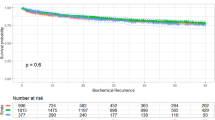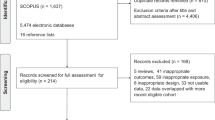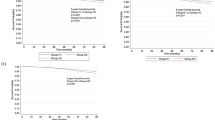Abstract
Background:
Accumulating evidence suggests that obesity is associated with tumor progression in prostate cancer (PCa) patients after radical prostatectomy (RP). We conducted a retrospective multicenter study to determine the effect of body mass index (BMI) on the clinicopathological characteristics and biochemical recurrence of PCa in Japanese men who underwent RP.
Methods:
The medical records of 1257 men with PCa treated by RP without neoadjuvant therapy at four medical institutes between 2001 and 2009 were retrospectively reviewed. Patients were categorized into four groups using the World Health Organization (WHO) BMI classification and BMI quartiles. Associations of the various BMI categories with clinicopathological characteristics and biochemical recurrences were statistically evaluated. Biochemical recurrence was defined as a PSA level of >0.2 ng ml–1.
Results:
Of the 1257 patients, 230 (18.3%) experienced biochemical recurrence during the median follow-up period of 49 months. The median BMI was 23.8 kg m–2, and 1.4% patients were underweight, 65.4% were of normal weight, 30.9% were overweight and 2.4% were obese (WHO classification). Preoperative PSA levels and PSA density (PSAD) tended to decrease as BMI increased. Pathological characteristics did not differ significantly among BMI categories. As per the WHO classification and quartile categories, biochemical recurrence rate was comparable among the BMI groups. After adjusting for other pre- and postoperative covariables, multivariate Cox proportional hazards analysis revealed that a high BMI did not have an independent impact on biochemical recurrence-free survival.
Conclusions:
Underweight Japanese PCa patients treated by RP had higher preoperative PSA levels and PSAD. High BMI was not associated with adverse pathological findings or increased biochemical recurrence rate in Japanese PCa patients treated with RP. Racial differences may exist in the relationship between obesity and outcomes of RP in PCa patients.
This is a preview of subscription content, access via your institution
Access options
Subscribe to this journal
Receive 4 print issues and online access
$259.00 per year
only $64.75 per issue
Buy this article
- Purchase on Springer Link
- Instant access to full article PDF
Prices may be subject to local taxes which are calculated during checkout

Similar content being viewed by others
References
Calle EE, Rodriguez C, Walker-Thurmond K, Thun MJ . Overweight, obesity, and mortality from cancer in a prospectively studied cohort of U.S. adults. N Engl J Med 2003; 348: 1625–1638.
Renehan AG, Tyson M, Egger M, Heller RF, Zwahlen M . Body-mass index and incidence of cancer: a systematic review and meta-analysis of prospective observational studies. Lancet 2008; 371: 569–578.
MacInnis RJ, English DR . Body size and composition and prostate cancer risk: systematic review and meta-regression analysis. Cancer Causes Control 2006; 17: 989–1003.
Discacciati A, Orsini N, Wolk A . Body mass index and incidence of localized and advanced prostate cancer--a dose-response meta-analysis of prospective studies. Ann Oncol 2012; 23: 1665–1671.
Banez LL, Hamilton RJ, Partin AW, Vollmer RT, Sun L, Rodriguez C et al. Obesity-related plasma hemodilution and PSA concentration among men with prostate cancer. JAMA 2007; 298: 2275–2280.
Parsons JK, Sarma AV, McVary K, Wei JT . Obesity and benign prostatic hyperplasia: clinical connections, emerging etiological paradigms and future directions. J Urol 2009; 182 (Suppl 6): S27–S31.
Culp S, Porter M . The effect of obesity and lower serum prostate-specific antigen levels on prostate-cancer screening results in American men. BJU Int 2009; 104: 1457–1461.
Amling CL, Kane CJ, Riffenburgh RH, Ward JF, Roberts JL, Lance RS et al. Relationship between obesity and race in predicting adverse pathologic variables in patients undergoing radical prostatectomy. Urology 2001; 58: 723–728.
Freedland SJ, Aronson WJ, Kane CJ, Presti JC Jr., Amling CL, Elashoff D et al. Impact of obesity on biochemical control after radical prostatectomy for clinically localized prostate cancer: a report by the Shared Equal Access Regional Cancer Hospital database study group. J Clin Oncol 2004; 22: 446–453.
Freedland SJ, Terris MK, Presti JC Jr., Amling CL, Kane CJ, Trock B et al. Obesity and biochemical outcome following radical prostatectomy for organ confined disease with negative surgical margins. J Urol 2004; 172: 520–524.
Freedland SJ, Isaacs WB, Mangold LA, Yiu SK, Grubb KA, Partin AW et al. Stronger association between obesity and biochemical progression after radical prostatectomy among men treated in the last 10 years. Clin Cancer Res 2005; 11: 2883–2888.
Bassett WW, Cooperberg MR, Sadetsky N, Silva S, DuChane J, Pasta DJ et al. Impact of obesity on prostate cancer recurrence after radical prostatectomy: data from CaPSURE. Urology 2005; 66: 1060–1065.
Loeb S, Yu X, Nadler RB, Roehl KA, Han M, Hawkins SA et al. Does body mass index affect preoperative prostate specific antigen velocity or pathological outcomes after radical prostatectomy? J Urol 2007; 177: 102–106.
Freedland SJ, Banez LL, Sun LL, Fitzsimons NJ, Moul JW . Obese men have higher-grade and larger tumors: an analysis of the duke prostate center database. Prostate Cancer Prostatic Dis 2009; 12: 259–263.
Ploussard G, de la Taille A, Bayoud Y, Durand X, Terry S, Xylinas E et al. The risk of upstaged disease increases with body mass index in low-risk prostate cancer patients eligible for active surveillance. Eur Urol 2012; 61: 356–362.
Magheli A, Rais-Bahrami S, Trock BJ, Humphreys EB, Partin AW, Han M et al. Impact of body mass index on biochemical recurrence rates after radical prostatectomy: an analysis utilizing propensity score matching. Urology 2008; 72: 1246–1251.
Jayachandran J, Banez LL, Aronson WJ, Terris MK, Presti JC Jr., Amling CL et al. Obesity as a predictor of adverse outcome across black and white race: results from the Shared Equal Access Regional Cancer Hospital (SEARCH) Database. Cancer 2009; 115: 5263–5271.
Lee SE, Lee WK, Jeong MS, Abdullajanov M, Kim DS, Park HZ et al. Is body mass index associated with pathological outcomes after radical prostatectomy in Korean men? BJU Int 2011; 107: 1250–1255.
Kok DE, van Roermund JG, Aben KK, van de Luijtgaarden MW, Karthaus HF, van Vierssen Trip OB et al. Body mass index is not a predictor of biochemical recurrence after radical prostatectomy in Dutch men diagnosed with prostate cancer. World J Urol 2011; 29: 695–701.
Ogden CL, Carroll MD, Curtin LR, McDowell MA, Tabak CJ, Flegal KM . Prevalence of overweight and obesity in the United States, 1999-2004. JAMA 2006; 295: 1549–1555.
Siddiqui SA, Inman BA, Sengupta S, Slezak JM, Bergstralh EJ, Leibovich BC et al. Obesity and survival after radical prostatectomy: a 10-year prospective cohort study. Cancer 2006; 107: 521–529.
WHO Expert Consultation. Appropriate body-mass index for Asian populations and its implications for policy and intervention strategies. Lancet 2004; 363: 157–163.
Hisasue S, Yanase M, Shindo T, Iwaki H, Fukuta F, Nishida S et al. Influence of body mass index and total testosterone level on biochemical recurrence following radical prostatectomy. Jpn J Clin Oncol 2008; 38: 129–133.
Komaru A, Kamiya N, Suzuki H, Endo T, Takano M, Yano M et al. Implications of body mass index in Japanese patients with prostate cancer who had undergone radical prostatectomy. Jpn J Clin Oncol 2010; 40: 353–359.
Isbarn H, Jeldres C, Budaus L, Salomon G, Schlomm T, Steuber T et al. Effect of body mass index on histopathologic parameters: results of large European contemporary consecutive open radical prostatectomy series. Urology 2009; 73: 615–619.
Baillargeon J, Pollock BH, Kristal AR, Bradshaw P, Hernandez J, Basler J et al. The association of body mass index and prostate-specific antigen in a population-based study. Cancer 2005; 103: 1092–1095.
Werny DM, Thompson T, Saraiya M, Freedman D, Kottiri BJ, German RR et al. Obesity is negatively associated with prostate-specific antigen in U.S. men, 2001–2004. Cancer Epidemiology Biomarkers Prevention 2007; 16: 70–76.
Freedland SJ, Platz EA, Presti JC Jr., Aronson WJ, Amling CL, Kane CJ et al. Obesity, serum prostate specific antigen and prostate size: implications for prostate cancer detection. J Urol 2006; 175: 500–504.
Park SG, Choi HC, Cho B, Kwon YM, Kwon HT, Park JH . Effect of central obesity on prostate specific antigen measured by computerized tomography: related markers and prostate volume. J Urol 2012; 187: 1589–1593.
Bryniarski P, Paradysz A, Fryczkowski M . PSA mass as a marker of prostate cancer progression after radical prostatectomy. Med Sci Monitor 2011; 17: CR104–CR109.
Joshu CE, Mondul AM, Menke A, Meinhold C, Han M, Humphreys EB et al. Weight gain is associated with an increased risk of prostate cancer recurrence after prostatectomy in the PSA era. Cancer Prevention Research (Philadelphia, PA) 2011; 4: 544–551.
Discacciati A, Orsini N, Andersson SO, Andren O, Johansson JE, Wolk A . Body mass index in early and middle-late adulthood and risk of localised, advanced and fatal prostate cancer: a population-based prospective study. Br J Cancer 2011; 105: 1061–1068.
Author information
Authors and Affiliations
Corresponding author
Ethics declarations
Competing interests
The authors declare no conflict of interest.
Rights and permissions
About this article
Cite this article
Narita, S., Mitsuzuka, K., Yoneyama, T. et al. Impact of body mass index on clinicopathological outcome and biochemical recurrence after radical prostatectomy. Prostate Cancer Prostatic Dis 16, 271–276 (2013). https://doi.org/10.1038/pcan.2013.16
Received:
Revised:
Accepted:
Published:
Issue Date:
DOI: https://doi.org/10.1038/pcan.2013.16
Keywords
This article is cited by
-
Obesity and biochemical recurrence in clinically localised prostate cancer: a systematic review and meta-analysis of 86,490 patients
Prostate Cancer and Prostatic Diseases (2022)
-
Post-Diagnostic Dietary and Lifestyle Factors and Prostate Cancer Recurrence, Progression, and Mortality
Current Oncology Reports (2021)
-
Differences in risk factors for biochemical recurrence after radical prostatectomy stratified by the degree of obesity: Focused on surgical methods
Scientific Reports (2020)
-
The relationship between body-mass index, physical activity, and pathologic and clinical outcomes after radical prostatectomy for prostate cancer
World Journal of Urology (2019)
-
Body mass index is associated with higher Gleason score and biochemical recurrence risk following radical prostatectomy in Chinese men: a retrospective cohort study and meta-analysis
World Journal of Surgical Oncology (2015)



